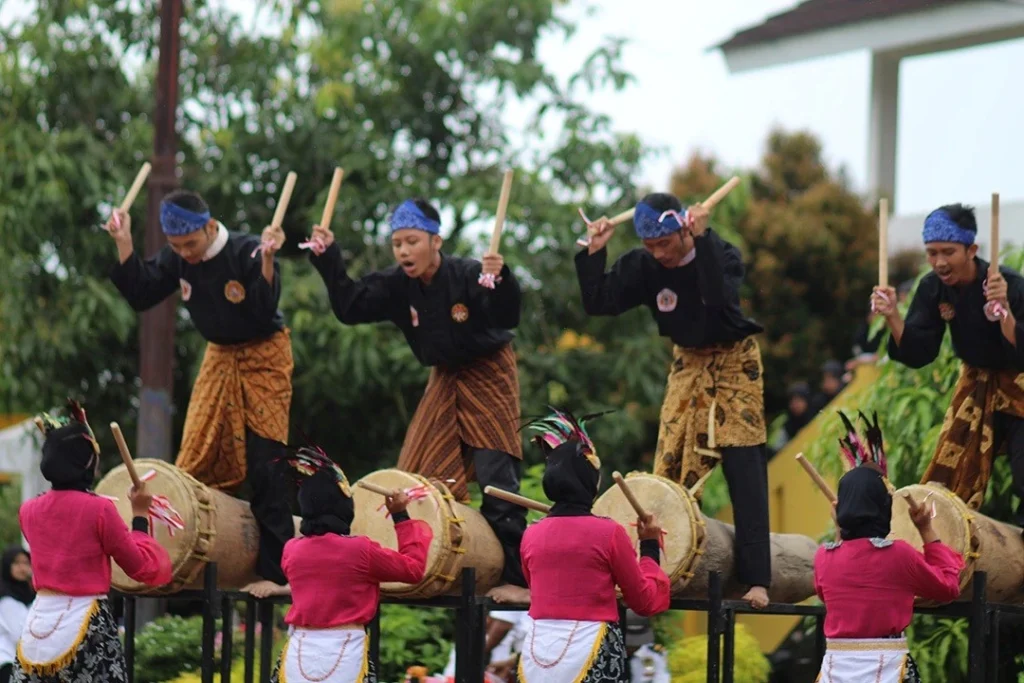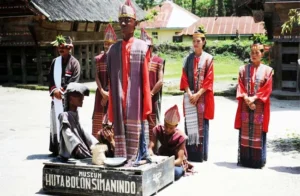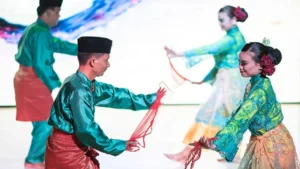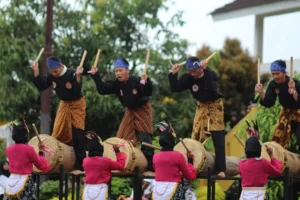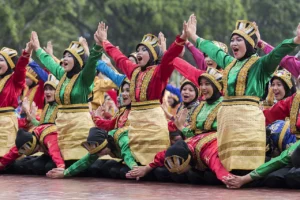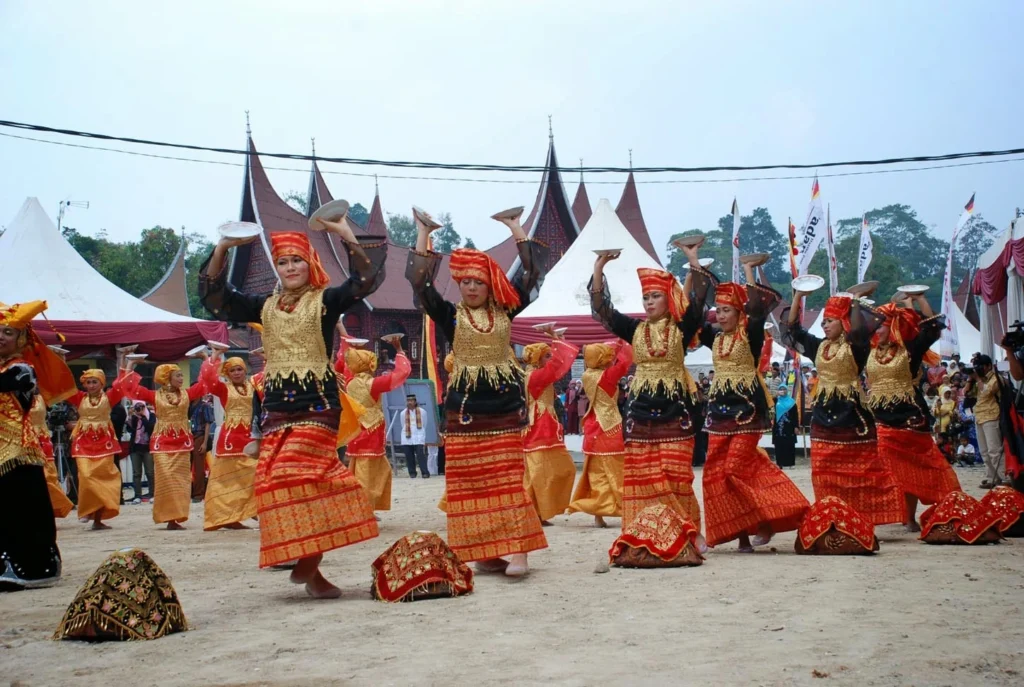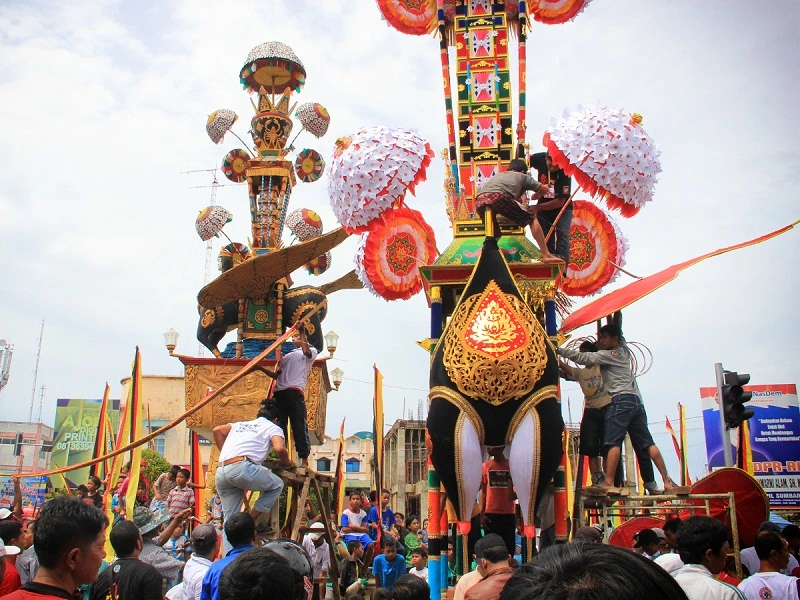Sumatra, an island rich in culture and natural beauty, not only offers stunning natural landscapes but also an enchanting artistic heritage. From north to south, each ethnic group in Sumatra has its own traditional dance, reflecting the wealth of preserved traditions and history. This article will explore the 9 traditional dances of Sumatra that captivate not only the heart but also constitute a precious heritage of Indonesia’s cultural diversity. Let’s delve into the beauty of Traditional Dances of Sumatra that reflect the uniqueness of each ethnic group.
9 Traditional Dances of Sumatra
1.Tari Indang
source: adat-tradisional.blogspot.com
The traditional Batak dance is an integral part of Indonesian cultural heritage, especially in the Sumatra region. One of the most remarkable dances is Tari Indang, which captivates with its combination of dynamic movements and distinctive music. During the Tari Indang performance, dancers form a solid circle, facing each other, following movements gracefully led by the dance leader. Emphasizing the cultural richness of Sumatra, especially in traditional dances, adds a special touch to this artistic expression. The music of gondang sabangunan accompanies the dancers, stimulating their spirits, enhancing the visual beauty, and harmonizing the movements.
Tari Indang is not just entertainment; it also carries a profound philosophical meaning about unity and harmony in the Batak community’s life. Describing joy and camaraderie through each movement, this dance reflects the high values cherished by Sumatra’s society. In this context, Traditional Dances of Sumatra, especially Tari Indang, becomes a symbol of Indonesian cultural diversity that must be preserved, appreciated as an integral element of national identity.
2.Tari Sigale-Gale
source: journal.momotrip.co.id
Originating from the Karo region, Tari Sigale-Gale emerges as a cultural beauty attracting the attention of many spectators. This Traditional Dances of Sumatra not only showcases the dancers’ skill in agile and joyful movements but also involves a wooden puppet called Sigale-Gale, which takes center stage. Sigale-Gale, performed by a dancer, becomes a symbol of life and happiness in the rich Karo tradition full of myths and legends. This dance is not just a form of entertainment but also conveys a message about the sense of community and joy in the Karo people’s lives.
Traditional Dances of Sumatra Tari Sigale-Gale, in a unique and captivating manner, presents the cultural richness of the land of Karo. Involving a wooden puppet animated by a dancer, this dance highlights agile and joyful movements, creating a delightful entertainment atmosphere. Beyond a mere artistic representation, Sigale-Gale becomes a symbol of life and happiness in the Karo tradition filled with myths and legends. By presenting Tari Sigale-Gale, the Karo community not only provides charming entertainment but also conveys rich cultural values to future generations.
3.Tari Piring
source: wandygoesmankhoto.blogspot.com
Tari Piring, or the plate dance, is part of the rich cultural heritage of Traditional Dances of Sumatra, particularly among the Minangkabau population that captivates many spectators. The agile movements of dancers holding plates in both hands are the main attraction of this dance. The coordination between dancers creates a captivating visual harmony, enriching the cultural experience. Traditional Minangkabau music, such as Talempong and Saluang, also accompanies this dance, adding a dramatic touch and reinforcing the cultural aspect in each performance.
Tari Piring, as an integral part of the tradition of Traditional Dances of Sumatra, testifies to the fascinating cultural diversity of the Minangkabau population. The agile movements involving plates in both hands showcase artistic richness and values passed down through generations. Traditional Minangkabau music is a faithful companion, creating a dramatic and profound atmosphere in Tari Piring. As a symbol of courage and beauty, this dance is not just an artistic performance but also a reflection of the strength of the daily values upheld by the Minangkabau population.
4.Tari Serampang Dua Belas
source: selasar.com
Tari Serampang Dua Belas, as part of the elegant Malay dance, is firmly rooted in Palembang, South Sumatra, and brings a distinctive captivating touch. With each graceful movement, this dance highlights Malay cultural beauty, creating a captivating harmony with music full of nuances. As a representation of Malay dance art, Tari Serampang Dua Belas is not only recognized as a form of entertainment. This Traditional Dances of Sumatra is often integrated into various official events and traditional ceremonies in Palembang, supporting and reinforcing the local cultural identity.
The elegance of Tari Serampang Dua Belas is not only visual but also reflects the traditional richness and subtlety of Malay culture. Being frequently presented in various official and traditional contexts, this dance has become an essential symbol of Palembang’s cultural identity. The use of Tari Serampang Dua Belas in official events and traditional ceremonies not only preserves cultural heritage but also enhances the pride of the Palembang population for the richness of Traditional Dances of Sumatra, which is unique and precious.
5.Tari Rampak Beduk
source: selasar.com
Originating from Aceh in northern Sumatra, Tari Rampak Beduk creates Indonesian artistic diversity with its distinctive energy. The main accessories of this dance are the fan and the drum, symbolizing strength and spirit in each movement. In this performance, dancers animate the stage with dynamic and passionate movements, creating a vibrant experience for the audience.
The uniqueness of Tari Rampak Beduk lies not only in its energetic aspect but also in its frequent presence at various festivals and traditional events. This dance is an integral part of Aceh’s cultural wealth, reinforcing local cultural identity. Presented in various cultural contexts, Tari Rampak Beduk becomes a means of celebrating the diversity of their traditional art while emphasizing the importance of preserving local cultural heritage.
6.Tari Tor-tor
source : pinterest.com
Originating from the Batak land, Tari Tor-tor emerges as a symbol of harmony and cultural richness in Batak society. This Traditional Dances of Sumatra represents the beauty of rhythmic movements, creating a joyful spectacle. Tari Tor-tor is not just a performing art but also an integral part of the rituals in Batak society’s life. Its frequent presence in various traditional ceremonies, weddings, and other significant events makes it an essential element that enhances the daily events of Batak society.
By showcasing Tari Tor-tor in various traditional life contexts, Batak society not only preserves its cultural heritage but also demonstrates pride in its cultural identity. This Traditional Dances of Sumatra is not just a form of entertainment but also reflects profound philosophical meanings about harmony and camaraderie in Batak society’s life. As a rich cultural symbol, Tari Tor-tor enriches Sumatra’s cultural journey and inspires the preservation and celebration of local cultural diversity.
7.Tari Rentak Bulian
source: budhayaasliindonesia.blogspot.com
Originating from Jambi, Sumatra, Tari Rentak Bulian highlights Indonesia’s artistic richness with its distinctive style, dynamic movements, and enchanting music. This dance is not only a form of artistic expression but also reflects the life and spirit of the Jambi community. Presented at various traditional ceremonies and local celebrations, Tari Rentak Bulian has become an inseparable part of Jambi’s cultural heritage.
With colorful costumes and energetic movements, Tari Rentak Bulian manages to represent the joy and spirit of the daily life of the Jambi community. Its frequent presence at traditional ceremonies and celebrations not only enriches the performance art but also strengthens the cultural identity of the Jambi community. This Traditional Dances of Sumatra, through its joyful and energetic visualization, serves as a means to celebrate the uniqueness and joy of daily life while promoting awareness of the importance of preserving local cultural heritage.
8.Likok Pulo Dance
source: likokpuloworld.blogspot.com
From the Mentawai Islands, the Likok Pulo dance emerges as a unique and authentic artistic expression, enriching Indonesia’s cultural diversity, especially Sumatra’s traditional dances. The graceful movements of this dance beautifully depict the daily life of Mentawai residents, particularly emphasizing hunting and fishing activities, adding a real and profound dimension to the performance.
The Likok Pulo dance, as an essential part of Sumatra’s artistic and cultural richness, not only offers visual beauty and graceful movements but also presents entertaining and moving storytelling for the audience. The uniqueness of the Likok Pulo dance is also reflected in the use of distinctive costumes and accessories such as leaf hats and natural jewelry, adding a touch of authenticity to the performance. The use of natural elements in costumes and accessories adds visual appeal and enriches the cultural significance of the Mentawai community.
As an essential component of Traditional Dances of Sumatra, the Likok Pulo dance is not just a precious cultural heritage but also creates a complete artistic experience by combining visual aspects, movements, and cultural meanings into a harmonious unity.
9.Tari Gandai
source : pinterest.com
The Gandai dance, as an integral part of Traditional Dances of Sumatra, originates from Riau and represents the joyous life of the Malay community. The elegant and agile movements of this dance create a captivating performance, making Gandai dance an indispensable element of Riau’s artistic and cultural richness. The freshness and beauty of the movements in the Gandai dance not only reflect the joy of the Malay community but also visually represent the enrichment of Traditional Dances of Sumatra heritage.
The Gandai dance celebrates not only the life of the Malay community in the cultural context of Riau but is also frequently presented at various events such as artistic festivals and weddings. Its continued existence and appreciation by future generations make the Gandai dance an ever-evolving artistic heritage, preserving its authenticity. With its distinctive presentation at cultural events, this Traditional Dance of Sumatra contributes to maintaining the diversity of traditional arts and transmitting cultural values to future generations.
Conclusion
From the northern tip to the southern tip, the diversity of Indonesian arts and culture is reflected in the 11 Traditional Dances of Sumatra described above. Each Traditional Dances of Sumatra tells a unique and philosophical story, reflecting the life and values of the local community. The grace of movements, the richness of colorful costumes, and the distinctive music of each Traditional Dances of Sumatra create an unforgettable experience for the audience, illustrating the richness of Indonesian cultural heritage. The importance of preserving and developing traditional dances, including Sumatra’s traditional dances, is highlighted in efforts to transmit this rich cultural heritage to future generations.
By continuing to appreciate and preserve Sumatra’s traditional dances, it is hoped that younger generations can understand and feel the beauty and meaning of each dance movement. May this article serve as an informative and inspiring guide for those wishing to explore further the wonders of Traditional Dances of Sumatra, strengthening awareness of cultural diversity and ensuring that this heritage remains alive and respected throughout the long journey of the Indonesian nation. Plan your trip to Sumatra to discover for yourself the beauty of nature and dance on the island of Sumatra.

